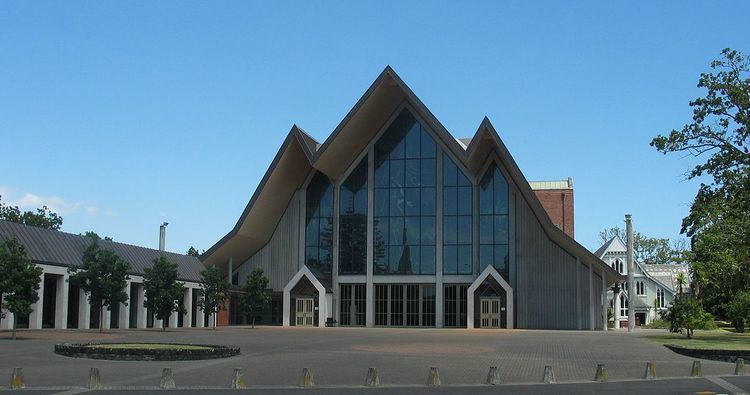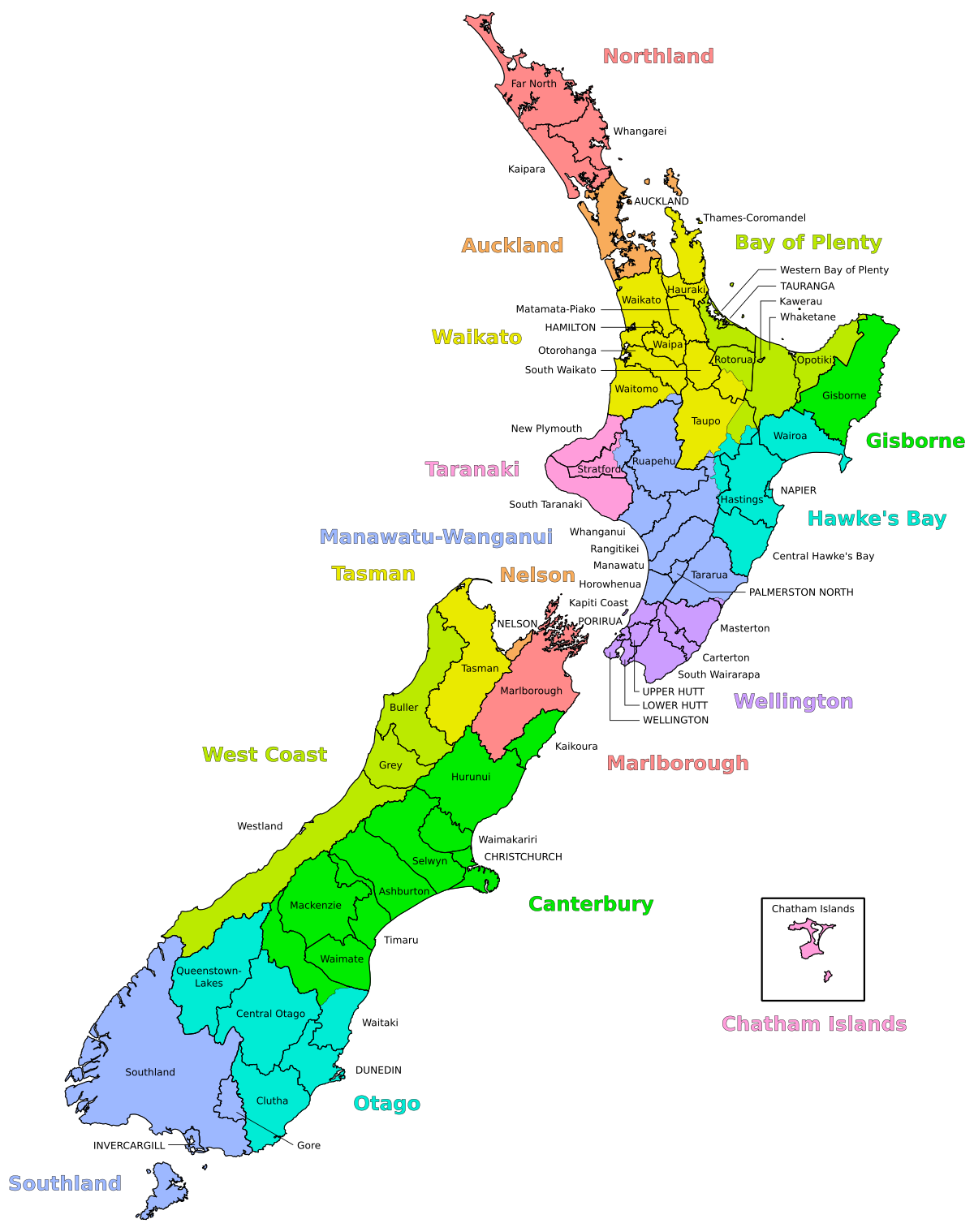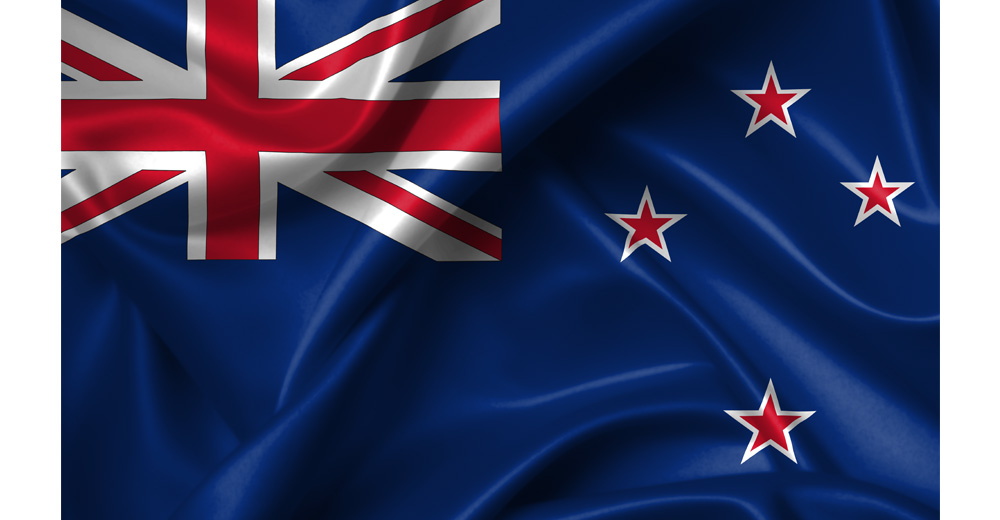Population: 4,794 million(2017)
Area: 268 021 km²
Capital City: Wellington
About New Zealand
New Zealand is a sovereign island country in the southwestern Pacific Ocean. The country geographically comprises two main landmasses—the North Island, and the South Island (Te Waipounamu)—and around 600 smaller islands. New Zealand is situated some 1,500 kilometres (900 mi) east of Australia across the Tasman Sea and roughly 1,000 kilometres (600 mi) south of the Pacific island areas of New Caledonia, Fiji, and Tonga. Because of its remoteness, it was one of the last lands to be settled by humans. During its long period of isolation, New Zealand developed a distinct biodiversity of animal, fungal, and plant life. The country's varied topography and its sharp mountain peaks, such as the Southern Alps, owe much to the tectonic uplift of land and volcanic eruptions.
Currency
The currency is the New Zealand dollar, informally known as the "Kiwi dollar"; it also circulates in the Cook Islands (see Cook Islands dollar), Niue, Tokelau, and the Pitcairn Islands.
Climate
New Zealand's climate is predominantly temperate maritime (Köppen: Cfb), with mean annual temperatures ranging from 10 °C (50 °F) in the south to 16 °C (61 °F) in the north. Historical maxima and minima are 42.4 °C (108.32 °F) in Rangiora, Canterbury and −25.6 °C (−14.08 °F) in Ranfurly, Otago. Conditions vary sharply across regions from extremely wet on the West Coast of the South Island to almost semi-arid in Central Otago and the Mackenzie Basin of inland Canterbury and subtropical in Northland. Of the seven largest cities, Christchurch is the driest, receiving on average only 640 millimetres (25 in) of rain per year and Wellington the wettest, receiving almost twice that amount. Auckland, Wellington and Christchurch all receive a yearly average of more than 2,000 hours of sunshine. The southern and southwestern parts of the South Island have a cooler and cloudier climate, with around 1,400–1,600 hours; the northern and northeastern parts of the South Island are the sunniest areas of the country and receive about 2,400–2,500 hours. The general snow season is early June until early October, though cold snaps can occur outside this season. Snowfall is common in the eastern and southern parts of the South Island and mountain areas across the country.
Languages
English is the predominant language in New Zealand, spoken by 96.1% of the population. New Zealand English is similar to Australian English and many speakers from the Northern Hemisphere are unable to tell the accents apart. The most prominent differences between the New Zealand English dialect and other English dialects are the shifts in the short front vowels: the short-"i" sound (as in "kit") has centralised towards the schwa sound (the "a" in "comma" and "about"); the short-"e" sound (as in "dress") has moved towards the short-"i" sound; and the short-"a" sound (as in "trap") has moved to the short-"e" sound.
Economy
New Zealand has an advanced market economy, ranked 16th in the 2018 Human Development Index and third in the 2018 Index of Economic Freedom. It is a high-income economy with a nominal gross domestic product (GDP) per capita of US$36,254.
Historically, extractive industries have contributed strongly to New Zealand's economy, focussing at different times on sealing, whaling, flax, gold, kauri gum, and native timber. The first shipment of refrigerated meat on the Dunedin in 1882 led to the establishment of meat and dairy exports to Britain, a trade which provided the basis for strong economic growth in New Zealand. High demand for agricultural products from the United Kingdom and the United States helped New Zealanders achieve higher living standards than both Australia and Western Europe in the 1950s and 1960s. In 1973, New Zealand's export market was reduced when the United Kingdom joined the European Community and other compounding factors, such as the 1973 oil and 1979 energy crises, led to a severe economic depression. Living standards in New Zealand fell behind those of Australia and Western Europe, and by 1982 New Zealand had the lowest per-capita income of all the developed nations surveyed by the World Bank. In the mid-1980s New Zealand deregulated its agricultural sector by phasing out subsidies over a three-year period. Since 1984, successive governments engaged in major macroeconomic restructuring (known first as Rogernomics and then Ruthanasia), rapidly transforming New Zealand from a protected and highly regulated economy to a liberalised free-trade economy.
Unemployment peaked above 10% in 1991 and 1992, following the 1987 share market crash, but eventually fell to a record low (since 1986) of 3.7% in 2007 (ranking third from twenty-seven comparable OECD nations). However, the global financial crisis that followed had a major impact on New Zealand, with the GDP shrinking for five consecutive quarters, the longest recession in over thirty years, and unemployment rising back to 7% in late 2009. Unemployment rates for different age groups follow similar trends, but are consistently higher among youth. In the December 2014 quarter, the general unemployment rate was around 5.8%, while the unemployment rate for youth aged 15 to 21 was 15.6%. New Zealand has experienced a series of "brain drains" since the 1970s that still continue today. Nearly one quarter of highly skilled workers live overseas, mostly in Australia and Britain, which is the largest proportion from any developed nation. In recent decades, however, a "brain gain" has brought in educated professionals from Europe and less developed countries. Today New Zealand's economy benefits from a high level of innovation.
Education
Primary and secondary schooling is compulsory for children aged 6 to 16, with the majority attending from the age of 5. There are 13 school years and attending state (public) schools is free to New Zealand citizens and permanent residents from a person's 5th birthday to the end of the calendar year following their 19th birthday. New Zealand has an adult literacy rate of 99%, and over half of the population aged 15 to 29 hold a tertiary qualification. There are five types of government-owned tertiary institutions: universities, colleges of education, polytechnics, specialist colleges, and wānanga, in addition to private training establishments. In the adult population 14.2% have a bachelor's degree or higher, 30.4% have some form of secondary qualification as their highest qualification and 22.4% have no formal qualification. The OECD's Programme for International Student Assessment ranks New Zealand's education system as the seventh best in the world, with students performing exceptionally well in reading, mathematics and science.
Religion

Christianity is the predominant religion in New Zealand, although its society is among the most secular in the world. In the 2013 census, 55.0% of the population identified with one or more religions, including 49.0% identifying as Christians. Another 41.9% indicated that they had no religion. The main Christian denominations are, by number of adherents, Roman Catholicism (12.6%), Anglicanism (11.8%), Presbyterianism (8.5%) and "Christian not further defined" (i.e. people identifying as Christian but not stating the denomination, 5.5%). The Māori-based Ringatū and Rātana religions (1.4%) are also Christian in origin. Immigration and demographic change in recent decades has contributed to the growth of minority religions, such as Hinduism (2.1%), Buddhism (1.5%), Islam (1.2%) and Sikhism (0.5%). The Auckland Region exhibited the greatest religious diversity.
Culture

Early Māori adapted the tropically based east Polynesian culture in line with the challenges associated with a larger and more diverse environment, eventually developing their own distinctive culture. Social organisation was largely communal with families (whānau), subtribes (hapū) and tribes (iwi) ruled by a chief (rangatira), whose position was subject to the community's approval. The British and Irish immigrants brought aspects of their own culture to New Zealand and also influenced Māori culture, particularly with the introduction of Christianity. However, Māori still regard their allegiance to tribal groups as a vital part of their identity, and Māori kinship roles resemble those of other Polynesian peoples. More recently American, Australian, Asian and other European cultures have exerted influence on New Zealand. Non-Māori Polynesian cultures are also apparent, with Pasifika, the world's largest Polynesian festival, now an annual event in Auckland.
The largely rural life in early New Zealand led to the image of New Zealanders being rugged, industrious problem solvers. Modesty was expected and enforced through the "tall poppy syndrome", where high achievers received harsh criticism. At the time New Zealand was not known as an intellectual country. From the early 20th century until the late 1960s, Māori culture was suppressed by the attempted assimilation of Māori into British New Zealanders. In the 1960s, as tertiary education became more available and cities expanded urban culture began to dominate. However, rural imagery and themes are common in New Zealand's art, literature and media.
New Zealand's national symbols are influenced by natural, historical, and Māori sources. The silver fern is an emblem appearing on army insignia and sporting team uniforms. Certain items of popular culture thought to be unique to New Zealand are called "Kiwiana".
Government and politics
New Zealand is a constitutional monarchy with a parliamentary democracy, although its constitution is not codified. Elizabeth II is the Queen of New Zealand and thus the head of state. The Queen is represented by the Governor-General, whom she appoints on the advice of the Prime Minister. The Governor-General can exercise the Crown's prerogative powers, such as reviewing cases of injustice and making appointments of ministers, ambassadors and other key public officials, and in rare situations, the reserve powers (e.g. the power to dissolve Parliament or refuse the Royal Assent of a bill into law). The powers of the Queen and the Governor-General are limited by constitutional constraints and they cannot normally be exercised without the advice of ministers.
The New Zealand Parliament holds legislative power and consists of the Queen and the House of Representatives. It also included an upper house, the Legislative Council, until this was abolished in 1950. The supremacy of parliament, over the Crown and other government institutions, was established in England by the Bill of Rights 1689 and has been ratified as law in New Zealand. The House of Representatives is democratically elected and a government is formed from the party or coalition with the majority of seats. If no majority is formed, a minority government can be formed if support from other parties during confidence and supply votes is assured. The Governor-General appoints ministers under advice from the Prime Minister, who is by convention the parliamentary leader of the governing party or coalition. Cabinet, formed by ministers and led by the Prime Minister, is the highest policy-making body in government and responsible for deciding significant government actions. Members of Cabinet make major decisions collectively, and are therefore collectively responsible for the consequences of these decisions.
Cuisine
The national cuisine has been described as Pacific Rim, incorporating the native Māori cuisine and diverse culinary traditions introduced by settlers and immigrants from Europe, Polynesia and Asia. New Zealand yields produce from land and sea—most crops and livestock, such as maize, potatoes and pigs, were gradually introduced by the early European settlers. Distinctive ingredients or dishes include lamb, salmon, kōura (crayfish), dredge oysters, whitebait, pāua (abalone), mussels, scallops, pipis and tuatua (both are types of New Zealand shellfish), kūmara (sweet potato), kiwifruit, tamarillo and pavlova (considered a national dish). A hāngi is a traditional Māori method of cooking food using heated rocks buried in a pit oven. After European colonisation, Māori began cooking with pots and ovens and the hāngi was used less frequently, although it is still used for formal occasions such as tangihanga.














